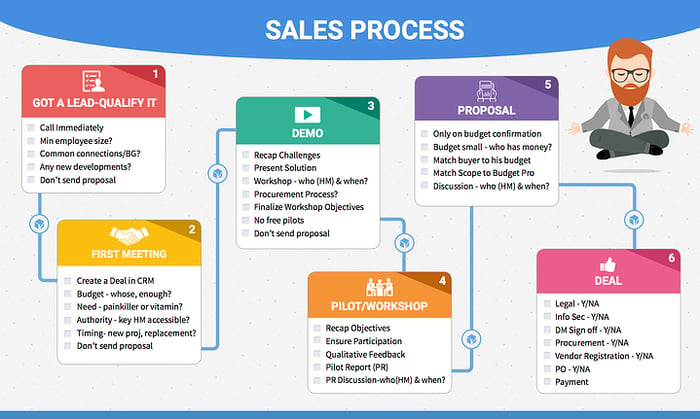
So you have a sales process in place, but is your team following it?
It’s happened even in the best of sales teams. A sales process is established but some sales reps work around it. Or some don’t even follow it at all. A lead is not properly qualified before hand-off; data is not recorded in the CRM; leads get lost in the pipeline—and other mishaps that happen just because a sales process was not implemented and followed.
It’s frustrating for managers and supervisors, but you have to step back and think, “Why isn’t the process being followed?” Unless your sales reps are just plain stubborn (and this requires your immediate action!), chances are the sales process is broken or it’s only clear to you, and not to everybody else.
It can happen. If a simple order is screwed up or not followed sometimes, what more for a whole process?
So as sales manager, what can you do to make sure that your sales process is followed to the letter by your entire team? Here are 8 strategies you can implement starting today:
1. Visualize it
After considering many options, one CEO realized that he only needed a simple solution to get his sales team to follow the sales process: a poster. Yes, the addition of a sales poster in their sales floor caused the rate of deviation from the process to come down to less than 20% of cases, a significant improvement from the previous level of more than 50%.

(source)
Every time there was any confusion, his reps would just quickly glance at the poster, and they are clearer on what needs to be achieved on each step; if the deal is ready to move to the next step; or if something is missing in the deal and what needs to be done. And as for the CEO/manager, it helped him do more meaningful reviews. He can just refer to the poster when doing a quick check on key deals and figure out if there are issues to be resolved.
To make your own poster, make sure that your sales process has been thoroughly analyzed for best and worst practices and has been tried and tested. And make sure to keep the design simple and easy to understand and reference by everyone.
2. Conduct a complete briefing
It’s not enough that you visualize your sales process in a poster, post it up, and call it a day. Your reps need a complete briefing. They need to understand and appreciate the value of the whole process, and not just follow it blindly.
Walk your sales reps through the sales process and explain the value of each step.
- Why is this step crucial to the next step?
- What positive outcomes do you achieve with this step?
- What issues are prevented with this step?
Relating your sales goals and sales plan to the process also helps communicate its efficiency and importance. It helps sales reps understand the whys and not just the whats and hows.
3. Keep it simple
Sales reps have more than enough things to do in a day. Adding to their tasks just make them unproductive. Do not complicate your sales process for your reps. Besides, complication just leads to a lot of confusion and miscommunication.
The sales process should be simple. Keep the steps to about four to eight. Anything less would seem incomplete, and anything more just seems too intricate or elaborate and counterproductive.

4. Centralize in a CRM
Your CRM should function as the go-to platform for your sales reps. Use it to centralize all information or data: customer profiles and activities, sales activities (call, emails, presentations, meetings, etc.), customer feedback and requests, data and analytics, and the like. This way, sales reps can refer to one place when accessing files or information they need to pursue leads. The CRM also allows for smoother collaboration across all teams or departments.
To gain maximum use of your CRM, make sure to employ best practices.
5. Prepare and activate sales enablement tools
Sales enablement is a system that provides sales teams with strategies, processes, tools, technology, and other resources to help them sell more effectively. Make sure that you have accounted for and made a list of all these strategies, processes, tools, and technology. These may include:
- Content (scripts, case studies, email templates, white papers, competitive analysis)
- Sales collateral (company overview, company brochure, presentation deck, etc.)
- Tool and gadgets (mobile phone, tablet, laptop, etc.)
- Software and technology (CRM, Wi-Fi, file sharing, etc.)
It pays to know what you have in your tech stack—and how each one can help in every step of the process. Then check what else your sales reps may need (and not need) for the fulfillment of their tasks in the process.
An integral part of sales enablement is sales and marketing teamwork, so make sure that both teams are perfectly aligned.
6. Document it in a playbook
If you have a brand manual for marketing, why not have a sales manual for sales reps? Having a playbook for everything the sales reps will need in closing a deal—steps, strategies, techniques, tips, best practices, value propositions, and the like—is not only very useful, it’s also very smart. Sales reps can refer to it anytime, and they are guaranteed to learn something new each time or at least refresh some of their stale tactics.
7. Update the process when needed
Always review what you have to make room for improvements. Don’t think that the sales process you follow is fool-proof for many years. The industry moves at such a fast pace, and the market is constantly evolving as well. It's best to be on your toes and be mindful of what’s relevant and what needs to be implemented.
Sometimes a process becomes broken because it’s become stagnant or redundant. Don’t fall into that trap and be open to new ideas.
8. Be available for microtraining
Sales managers need to be available for coaching when needed. While sales trainings happen during onboarding, managers should always be accessible for quick coaching anytime. Some sales reps won’t get the process immediately; some will need more mentoring. And supervisors should have the patience and the tenacity to help them improve. Besides, learning should be a constant in the sales workplace.
Photos from Pexels. Main image by Lukas





